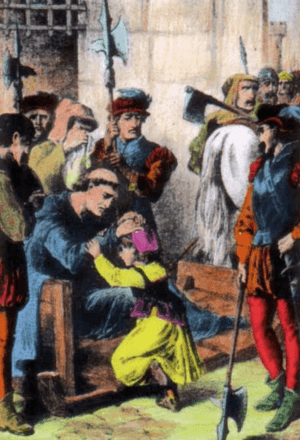James Fenn facts for kids
Quick facts for kids BlessedJames Fenn |
|
|---|---|
 |
|
| Martyr | |
| Born | c. 1540 Montacute, Somersetshire |
| Died | 12 February 1584 Tyburn, London, England |
| Honored in | Catholic Church |
| Beatified | 15 December 1929 by Pope Pius XI |
| Feast | 12 February |
| Influences | John Fenn |
James Fenn (born around 1540 – died February 12, 1584) was an English Catholic priest. He is known as a martyr, meaning he died for his religious beliefs. He was later declared "Blessed" by Pope Pius XI on December 15, 1929.
James Fenn was the brother of John Fenn, who was also a Catholic priest and writer. All three Fenn brothers, including Robert, were talented singers and scholars from a young age. Before becoming a priest when he was about 40, James Fenn was married and had a son and a daughter. He became a widower before his ordination. He was executed because he remained loyal to the Catholic Church, which was against the rules at the time that demanded everyone recognize the English monarch as the head of the Church of England.
Contents
James Fenn's Early Life and Education
James Fenn was born around 1540 in a place called Montacute, in Somersetshire, England. In 1544, when he was very young, he became a chorister at New College, Oxford. His singing skills helped him get a place at Corpus Christi College.
By November 1558, he was ready to get his university degree. However, he refused to take the Oath of Supremacy. This oath would have made him swear loyalty to Queen Elizabeth I as the main leader of the Church of England. At that time, many people at the university also had problems with the oath. So, the government temporarily stopped requiring it for students getting degrees at the University of Oxford.
Fenn received his degree on November 22, 1559. But a year later, in November 1560, he was expelled from the university, and his degree was taken away. He stayed at the university for a bit longer, teaching students at Gloucester Hall. However, he soon decided it was no longer safe for him there and moved back to Somersetshire.
Life in Somerset and Becoming a Priest
Back in Somerset, James Fenn became a tutor. He got married and had children. One time, while visiting his father in Wells, he was arrested by Bishop Gilbert Berkeley. This was because he again refused to take the oath of loyalty to the Queen as head of the church. However, he was released because there had been no official reason to make him take the oath at that moment.
His father gave him a house in Montacute, where he moved with his family. The local church leader wanted him charged for not attending church services, which was against a law called the Act of Uniformity. On the advice of a relative, Fenn went into hiding for two months. During this time, his wife sadly passed away. After making arrangements for his children, he left the area and started working for Sir Nicholas Poyntz in Gloucestershire.
While working there, he met a priest, possibly John Colleton. This priest suggested that Fenn consider becoming a priest himself. In 1579, Fenn traveled to Rheims (now in France) and was ordained as a priest in Châlons in April 1580.
Return to England and Arrest
After becoming a priest, James Fenn returned to Somersetshire in May 1580. He worked quietly for more than a year without trouble. However, in July 1581, another priest named Edmund Campion and Father Colloton were arrested. This caused a lot of excitement and fear. Fenn was then arrested as someone suspected of refusing to attend Church of England services, a practice known as recusancy. He eventually ended up in a prison called the Marshalsea.
While in prison, Fenn was given some freedom. He spent about two years helping other prisoners. Eventually, he was recognized, possibly by a spy named Thomas Dodwell.
Trial and Execution
On February 7, 1584, James Fenn and George Haydock were put on trial. They had only met the day before in the courtroom. They were found guilty of charges that included working against the government and causing trouble.
James Fenn was executed at Tyburn on February 12, 1584. He was executed along with George Haydock, John Munden, John Nutter, and Thomas Hemerford. In the crowd, he saw his daughter Frances. He tried to bless her as best as he could with his hands tied. After his execution, his head was placed on London Bridge, and parts of his body were displayed above the four main gates of London. This was a common practice at the time to warn others.
Beatification
James Fenn was officially declared "Blessed" by Pope Pius XI on December 15, 1929. The Catholic Church remembers him on February 12 each year.
See also
- Catholic Church in the United Kingdom
- Douai Martyrs

